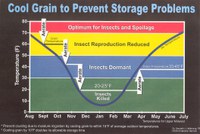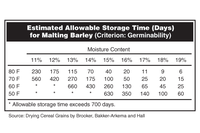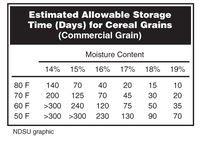Cool Stored Grain
(Click an image below to view a high-resolution image that can be downloaded)
Warm temperatures may have helped this year’s grain harvest, but those temperatures also may have created conditions that can cause stored grain to deteriorate.
“Harvested grain temperatures of about 100 degrees are being reported,” says Ken Hellevang, a North Dakota State University Extension Service agricultural engineer.
The optimum temperature for insect infestations and mold growth is about 80 degrees. Temperatures below about 70 degrees slow insect reproduction and feeding activity, and insects are dormant below about 50 degrees.
Hellevang says the best way to keep stored grain from deteriorating or becoming infested with insects is to cool it.
The allowable storage time, which is related to mold growth, is approximately doubled for each 10 degrees the grain is cooled. For example, the allowable storage time of 16 percent moisture content wheat is about 40 days at 80 degrees, 70 days at 70 degrees, 120 days at 60 degrees and 230 days at 50 degrees.
Most allowable storage time (AST) charts are for maintaining commercial grain quality. However, germination is lost due to fungi growth on the germ in less time than the commercial grain AST charts indicate. For example, the allowable storage time for 14 percent moisture malting barley, based on germination, actually is about 70 days at 80 degrees, 175 days at 70 degrees and 430 days at 60 degrees.
Stored grain should be cooled with an aeration system immediately after harvest. The goal should be to cool it to near or below 70 degrees, Hellevang says. As temperatures drop in the fall, stored grain will need to be cooled again, using aeration, whenever outdoor temperatures are 10 to 15 degrees cooler than grain temperatures.
In North Dakota, the typical August minimum temperature is about 60 degrees and the average high is about 80 degrees. September’s average minimum temperatures is about 50 degrees and the average maximum temperature is about 70 degrees. Thus, running the fans at night will reduce the grain temperature below 70 degrees during August, and continuous fan operation even will cool the grain during September.
To estimate the cooling time of 56 pounds-per-bushel grain, divide 15 by the airflow rate. For example, about 75 hours of fan time is required to cool the grain using an airflow rate of 0.2 cubic feet per minute per bushel.
Cooling times are the ratio of 56 pounds and the weight for grain with a different weight. For example, barley with a weight of 48 pounds per bushel will cool more quickly than corn at 56 pounds per bushel (48 divided by 56, which equals 0.86).
The grain temperature eventually should be cooled to about 25 degrees for winter storage in northern climates and 30 to 40 degrees in southern states. Air takes the path of least resistance, so cooling times will vary within a bin or grain storage. Measure grain temperature at several locations to ensure that all the grain has been cooled.
Moisture migration is another issue in stored grain, according to Hellevang. Moisture migration will increase the grain moisture content near the top center of the stored grain if the grain is about 20 degrees warmer than the average outdoor temperature.
That occurs because the air in the grain void spaces near the perimeter of the bin will cool as outdoor temperatures cool. The cool air will settle to the bottom of the bin along the bin perimeter, pushing air in the middle of the bin upward. As this air approaches cooler grain on or near the top surface of the bin, moisture will move from the air to the grain.
These convection currents can increase the moisture content of the grain at or near the top surface by several percentage points, leading to grain deterioration. The magnitude of moisture problems due to moisture migration increases with bin size. Cooling the grain as outdoor temperatures cool reduces the convection currents and moisture migration.
Grain stores best when it is dry, clean and cool. Weed seeds and fine foreign material, which usually are wetter than the grain, will accumulate in the center when the grain is loaded into a bin without a distributor, which can cause storage problems. This material should be removed from the grain by using a grain cleaner before placing the grain in the bin or by removing some of the grain from the bin after it has been filled, which sometimes is referred to as coring the bin.
“Stored grain must be monitored so insect infestations or grain spoilage can be detected before serious losses occur,” Hellevang advises. “Check stored grain biweekly during the critical fall months before the grain has been cooled to the winter storage temperature. After the grain has been cooled to winter storage temperature, check the grain at least monthly. Check and record the grain temperature and condition at several locations.”
Temperature history can be used to detect grain warming, which may indicate storage problems. Look for indications of problems, such as condensation on the roof or crusting of the grain surface. Probe to examine grain below the surface.
“If inspecting for insects, bring a grain sample indoors if the grain temperature is below 50 degrees and allow it to warm to room temperature,” Hellevang says. “Place the grain on a white surface and examine it for any insect activity.
“Fumigation is not recommended when grain is stored at temperatures below 60 degrees,” he adds. “Most storage problems can be controlled during the winter by cooling the grain.” More information about grain aeration, handling and storage is available at http://www.ag.ndsu.edu/extension-aben/post-harvest. You also can find this website by doing a search for NDSU grain drying and storage.
NDSU Agriculture Communication - Aug. 24, 2012
| Source: | Ken Hellevang, (701) 231-7243, kenneth.hellevang@ndsu.edu |
|---|---|
| Editor: | Ellen Crawford, (701) 231-5391, ellen.crawford@ndsu.edu |
Attachments
- PDF - Estimated Allowable Storage Time (Days) for Malting Barley (Criterion: Germinability) - (50.7353515625 kb)
- EPS - Estimated Allowable Storage Time (Days) for Malting Barley (Criterion: Germinability) - (223.7109375 kb)
- PDF - Estimated Allowable Storage Time (Days) for Cereal Grains (Commercial Grain) - (54.4873046875 kb)
- EPS - Estimated Allowable Storage Time (Days) for Cereal Grains (Commercial Grain) - (215.4931640625 kb)




